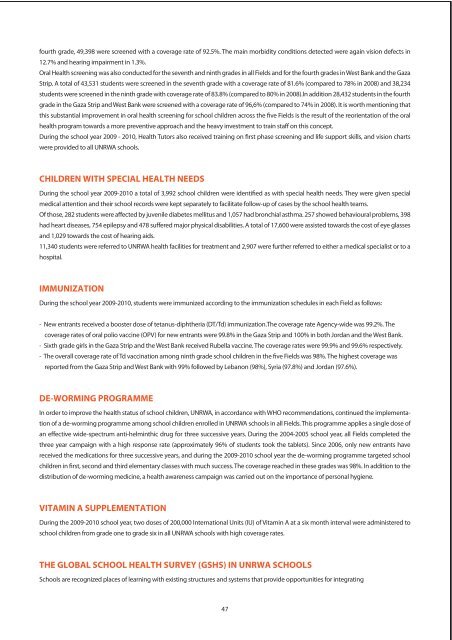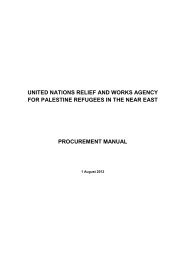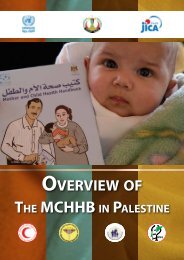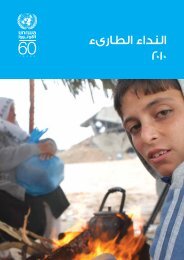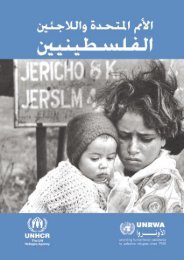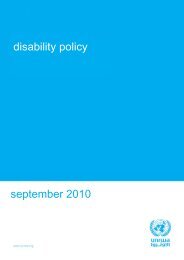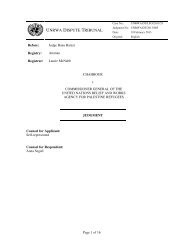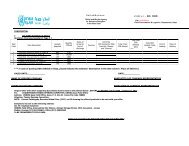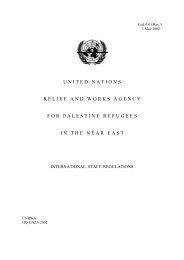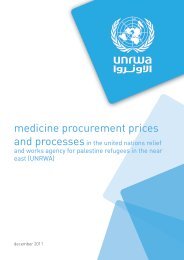Annual Report of the Department of Health 2010 - Unrwa
Annual Report of the Department of Health 2010 - Unrwa
Annual Report of the Department of Health 2010 - Unrwa
Create successful ePaper yourself
Turn your PDF publications into a flip-book with our unique Google optimized e-Paper software.
fourth grade, 49,398 were screened with a coverage rate <strong>of</strong> 92.5%. The main morbidity conditions detected were again vision defects in<br />
12.7% and hearing impairment in 1.3%.<br />
Oral <strong>Health</strong> screening was also conducted for <strong>the</strong> seventh and ninth grades in all Fields and for <strong>the</strong> fourth grades in West Bank and <strong>the</strong> Gaza<br />
Strip. A total <strong>of</strong> 43,531 students were screened in <strong>the</strong> seventh grade with a coverage rate <strong>of</strong> 81.6% (compared to 78% in 2008) and 38,234<br />
students were screened in <strong>the</strong> ninth grade with coverage rate <strong>of</strong> 83.8% (compared to 80% in 2008).In addition 28,432 students in <strong>the</strong> fourth<br />
grade in <strong>the</strong> Gaza Strip and West Bank were screened with a coverage rate <strong>of</strong> 96,6% (compared to 74% in 2008). It is worth mentioning that<br />
this substantial improvement in oral health screening for school children across <strong>the</strong> five Fields is <strong>the</strong> result <strong>of</strong> <strong>the</strong> reorientation <strong>of</strong> <strong>the</strong> oral<br />
health program towards a more preventive approach and <strong>the</strong> heavy investment to train staff on this concept.<br />
During <strong>the</strong> school year 2009 - <strong>2010</strong>, <strong>Health</strong> Tutors also received training on first phase screening and life support skills, and vision charts<br />
were provided to all UNRWA schools.<br />
CHILDREN WITH SPECIAL HEALTH NEEDS<br />
During <strong>the</strong> school year 2009-<strong>2010</strong> a total <strong>of</strong> 3,992 school children were identified as with special health needs. They were given special<br />
medical attention and <strong>the</strong>ir school records were kept separately to facilitate follow-up <strong>of</strong> cases by <strong>the</strong> school health teams.<br />
Of those, 282 students were affected by juvenile diabetes mellitus and 1,057 had bronchial asthma. 257 showed behavioural problems, 398<br />
had heart diseases, 754 epilepsy and 478 suffered major physical disabilities. A total <strong>of</strong> 17,600 were assisted towards <strong>the</strong> cost <strong>of</strong> eye glasses<br />
and 1,029 towards <strong>the</strong> cost <strong>of</strong> hearing aids.<br />
11,340 students were referred to UNRWA health facilities for treatment and 2,907 were fur<strong>the</strong>r referred to ei<strong>the</strong>r a medical specialist or to a<br />
hospital.<br />
IMMUNIZATION<br />
During <strong>the</strong> school year 2009-<strong>2010</strong>, students were immunized according to <strong>the</strong> immunization schedules in each Field as follows:<br />
- New entrants received a booster dose <strong>of</strong> tetanus-diph<strong>the</strong>ria (DT/Td) immunization.The coverage rate Agency-wide was 99.2%. The<br />
coverage rates <strong>of</strong> oral polio vaccine (OPV) for new entrants were 99.8% in <strong>the</strong> Gaza Strip and 100% in both Jordan and <strong>the</strong> West Bank.<br />
- Sixth grade girls in <strong>the</strong> Gaza Strip and <strong>the</strong> West Bank received Rubella vaccine. The coverage rates were 99.9% and 99.6% respectively.<br />
- The overall coverage rate <strong>of</strong> Td vaccination among ninth grade school children in <strong>the</strong> five Fields was 98%. The highest coverage was<br />
reported from <strong>the</strong> Gaza Strip and West Bank with 99% followed by Lebanon (98%), Syria (97.8%) and Jordan (97.6%).<br />
DE-WORMING PROGRAMME<br />
In order to improve <strong>the</strong> health status <strong>of</strong> school children, UNRWA, in accordance with WHO recommendations, continued <strong>the</strong> implementation<br />
<strong>of</strong> a de-worming programme among school children enrolled in UNRWA schools in all Fields. This programme applies a single dose <strong>of</strong><br />
an effective wide-spectrum anti-helminthic drug for three successive years. During <strong>the</strong> 2004-2005 school year, all Fields completed <strong>the</strong><br />
three year campaign with a high response rate (approximately 96% <strong>of</strong> students took <strong>the</strong> tablets). Since 2006, only new entrants have<br />
received <strong>the</strong> medications for three successive years, and during <strong>the</strong> 2009-<strong>2010</strong> school year <strong>the</strong> de-worming programme targeted school<br />
children in first, second and third elementary classes with much success. The coverage reached in <strong>the</strong>se grades was 98%. In addition to <strong>the</strong><br />
distribution <strong>of</strong> de-worming medicine, a health awareness campaign was carried out on <strong>the</strong> importance <strong>of</strong> personal hygiene.<br />
VITAMIN A SUPPLEMENTATION<br />
During <strong>the</strong> 2009-<strong>2010</strong> school year, two doses <strong>of</strong> 200,000 International Units (IU) <strong>of</strong> Vitamin A at a six month interval were administered to<br />
school children from grade one to grade six in all UNRWA schools with high coverage rates.<br />
THE GLOBAL SCHOOL HEALTH SURVEY (GSHS) IN UNRWA SCHOOLS<br />
Schools are recognized places <strong>of</strong> learning with existing structures and systems that provide opportunities for integrating<br />
47


